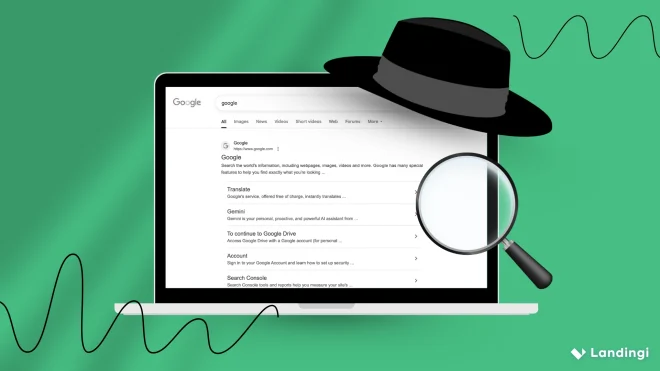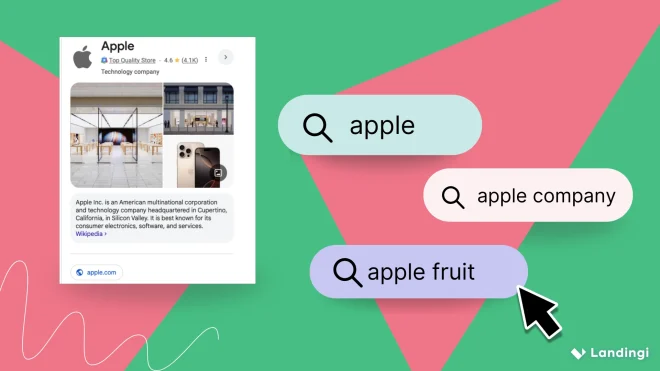E-E-A-T in Google SEO—short for Experience, Expertise, Authoritativeness, and Trustworthiness—is a set of quality signals Google uses to judge if your content is worth ranking. According to the official E-E-A-T guideline, it’s not just about what you say, but who’s saying it, how much they know, and whether they can be trusted.
Google favors content that feels real, helpful, and credible. In fact, a recent Semrush study showed that websites demonstrating strong E-E-A-T tend to perform significantly better in competitive search results—especially in areas like health, finance, or ecommerce, where trust makes or breaks the click.
So while E-E-A-T isn’t a single ranking factor you can measure in Search Console, it plays a big role in how your pages are judged, surfaced, and ranked. The upside? You can absolutely improve it—by showing real authorship, sharing lived experience, citing reliable sources, and making sure your website looks and feels trustworthy from top to bottom.

What Is E-E-A-T in SEO?
E-E-A-T is a quality framework Google uses to check if content is accurate, written by knowledgeable people, and generally worth showing to users. It stands for Experience, Expertise, Authoritativeness, and Trustworthiness.
This whole concept comes from the Search Quality Rater Guidelines—a document Google gives to human evaluators who manually review pages to help train the algorithm. These evaluators don’t change rankings themselves, but their insights help Google decide what high-quality content should look like, so the algorithm knows which pages actually deserve to rank well.

E-E-A-T isn’t a direct ranking factor. You won’t see it in your analytics or SEO tools. But it influences how Google assesses everything from who wrote the content, to how accurate and helpful it is, to whether the site has a good reputation across the web.
And it matters more for some topics than others. If your page gives advice about health, finances, safety, or anything that could impact someone’s life in a serious way—what Google calls YMYL, or Your Money or Your Life content—then E-E-A-T becomes even more important.
In 2022, Google added the first “E” for Experience, putting extra emphasis on firsthand knowledge. So now, if you’re writing about a product, tool, or process, it helps to actually use it. Readers—and Google—can tell the difference between real experience and a summary based on secondhand information.
So while E-E-A-T isn’t something you can “optimize for” in the usual sense, it’s absolutely something you can build over time—through better content, transparent authorship, stronger expertise, and consistency.
Pro-tip: Start by making sure it’s always clear who is behind your content. Add author bios with credentials, link to relevant profiles (like LinkedIn or published work), and don’t hide behind generic labels like “Editorial Team.” When readers know there’s a real, credible person behind the words, Google takes notice too.
Improve user trust and engagement by designing responsive landing pages with Landingi’s performance-optimized templates
Why Is EEAT Important in SEO?
EEAT is important because it’s Google’s way of evaluating quality. When the algorithm tries to decide which page deserves to rank higher, it looks beyond keywords—it looks at who’s talking, what they actually know, and whether they can be trusted.
Imagine this: You’re searching for advice on treating a skin condition. One result is a short article written by an anonymous contributor with no medical background, repeating general tips found on a dozen other blogs. Another is a detailed guide written by a dermatologist, explaining causes, treatment options, and including links to peer-reviewed studies. Which one would you trust? Google thinks the same way.
Pages that demonstrate strong E-E-A-T usually do a few things well.
- They speak from first-hand experience.
- They cite credible sources or show clear qualifications.
- They make it easy to see who’s behind the content—no hidden authors, no vague claims.
It’s about transparency, editorial responsibility, and a strong online reputation—all signals that help Google assess whether a page can be trusted. And this isn’t just theory. Google’s core updates over the years—especially the 2018 “Medic” update, which heavily impacted health and YMYL sites—have consistently favored content that demonstrates real expertise and trustworthiness, while demoting thin, unverified, or anonymous pages.
As Google puts it: “Trust is the most important member of the E-E-A-T family. The others contribute to it.” In other words, everything—your experience, your credentials, your site’s reputation—feeds into one big question: Can this be trusted? Because the higher the trust, the better your chances of ranking.
Build landing pages that look as trustworthy as your brand is — with one-click blocks for social proof, bios, and more.
What’s the Difference Between E-E-A-T and E-A-T in Google SEO?
The difference between E-E-A-T and E-A-T in Google SEO comes down to one key word: Experience. In late 2022, Google added the extra “E” to highlight the importance of firsthand knowledge as part of its broader focus on content quality signals.
It’s not enough to know something in theory—Google also wants to see that the person behind the content has actually done it.
Experience doesn’t replace traditional expertise. Degrees, certifications, and professional roles still matter—especially in YMYL topics. But lived experience adds an extra layer of credibility, especially in reviews, tutorials, and guides. It makes content feel real, grounded, and useful—and that can directly influence how it performs in search engine rankings.
This shift means Google’s looking at both who created the content and how closely connected they are to the subject. The more authentic the perspective, the stronger the signal.
How to Improve E-E-A-T in Google SEO?
To improve E-E-A-T in Google SEO, focus on five areas: clear author credentials, real-life experience in content, authoritative backlinks and mentions, strong online reputation, and trust-building website elements.
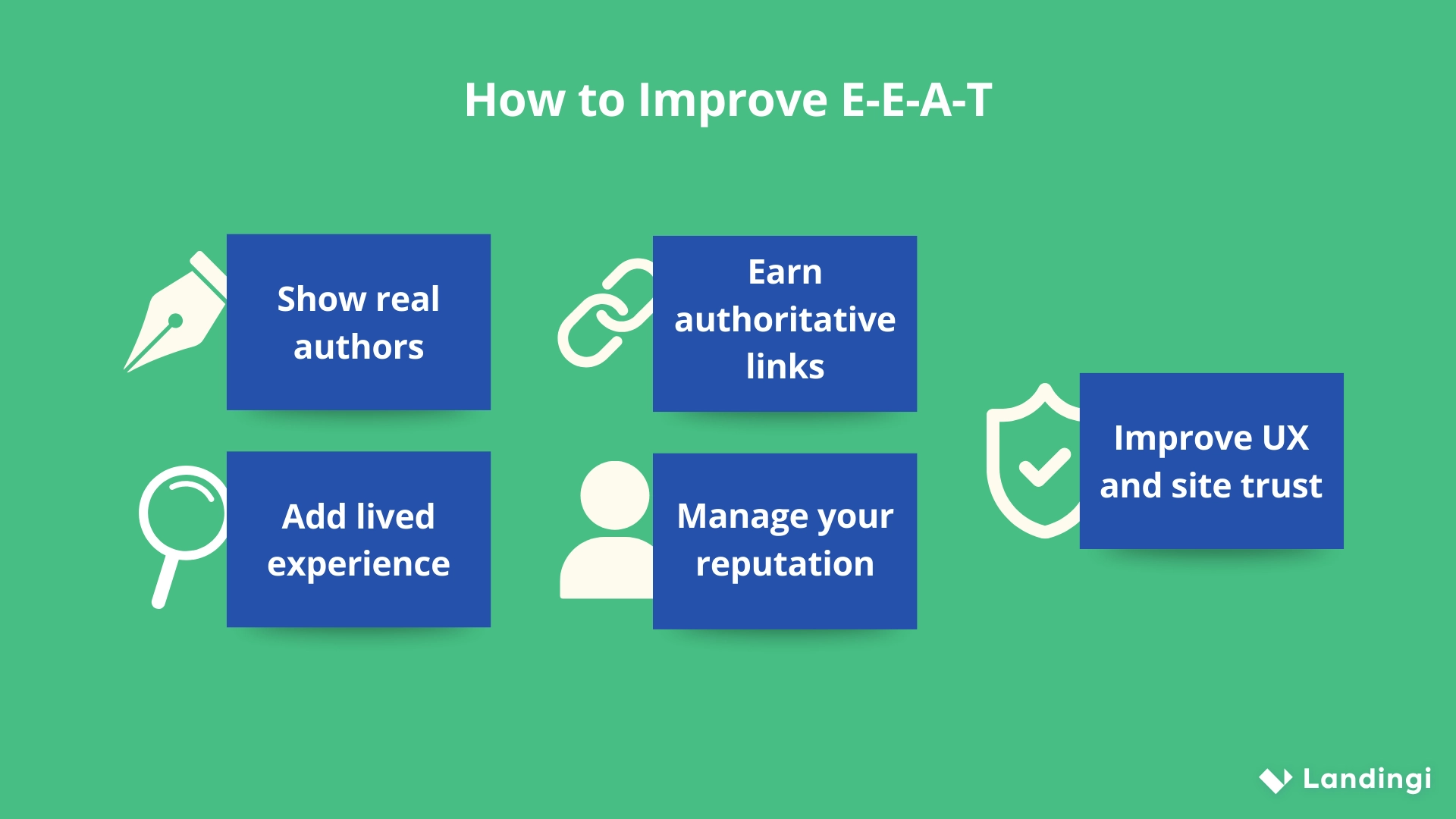
Showcase author credentials and bios
The first step is to make authorship visible and meaningful. Generic labels like “Editorial Team” don’t build trust. Every article should clearly state who wrote it, along with a short bio that explains why this person is qualified to cover the topic.
- Author name (not just “Team Blog”)
- Bio with relevant experience or expertise
- Links to social profiles (e.g., LinkedIn)
Relevant experience, credentials, past work—these details give content credibility. If someone reviews or fact-checks an article, say so. It’s a small touch that carries weight in Google’s eyes.
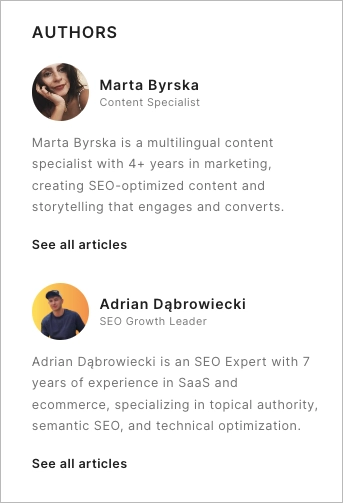
Include real-life experience in your content
Then, bring experience into the content itself. Whether you’re writing a product comparison, a tutorial, or a service guide, share specific, hands-on details that show you’ve actually used what you’re talking about. This is how you turn generic SEO content into something that feels authentic—something Google recognizes as helpful content. If it reads like anyone could’ve written it after five minutes of Googling, it won’t stand out.
Build authoritativeness with backlinks and mentions
One of the strongest ways to build authority is through backlinks and mentions from credible websites. Industry blogs, expert roundups, news outlets, university sources—these are all trust signals that show others recognize your content as valuable. Gary Illyes, Google Webmaster Trends Analyst, once summed it up perfectly: “E-A-T is largely based on links and mentions on authoritative sites.” Earning those links requires a smart mix of content marketing, digital PR, and relationship-building.
Manage your online reputation
Don’t forget your brand’s online reputation. What shows up when someone searches your name? Encourage satisfied customers to leave public reviews. Respond to negative feedback with transparency and professionalism. People (and algorithms) notice how you handle feedback.
Improve transparency and UX on your website
Finally, look at your website through a trust-focused lens. Google’s quality raters check for clear signals of transparency: a solid About page, easy-to-find contact info, privacy and return policies (especially for ecommerce), and secure HTTPS. Even design matters—cluttered, outdated layouts can quietly erode trust.
All of these elements together send one message: this site is credible, and its content was created by real people with real knowledge. That’s what E-E-A-T is about—and it’s what Google wants to rank.
Drop in testimonials, case studies, and credible sources to show Google (and users) you walk the talk.
What’s the Importance of E-E-A-T in On-Site SEO?
E-E-A-T matters in on-site SEO because it directly shapes how your content is perceived—by both users and Google. It’s no longer just about having the “right” keywords in the right places. Google also wants to understand: Can this source be trusted? Is the content safe, accurate, and helpful? And those answers often live on the page itself.
On-page trust signals are what Google—and your visitors—use to make quick credibility judgments. They function like cues in a conversation: they don’t just say what you’re telling me, but why I should believe you.
This includes clear author bylines that link to detailed contributor bios, outlining who created the content and what qualifies them to speak on the topic. It means linking out to original, authoritative sources—not just for SEO, but to show you’re part of a trusted information ecosystem.
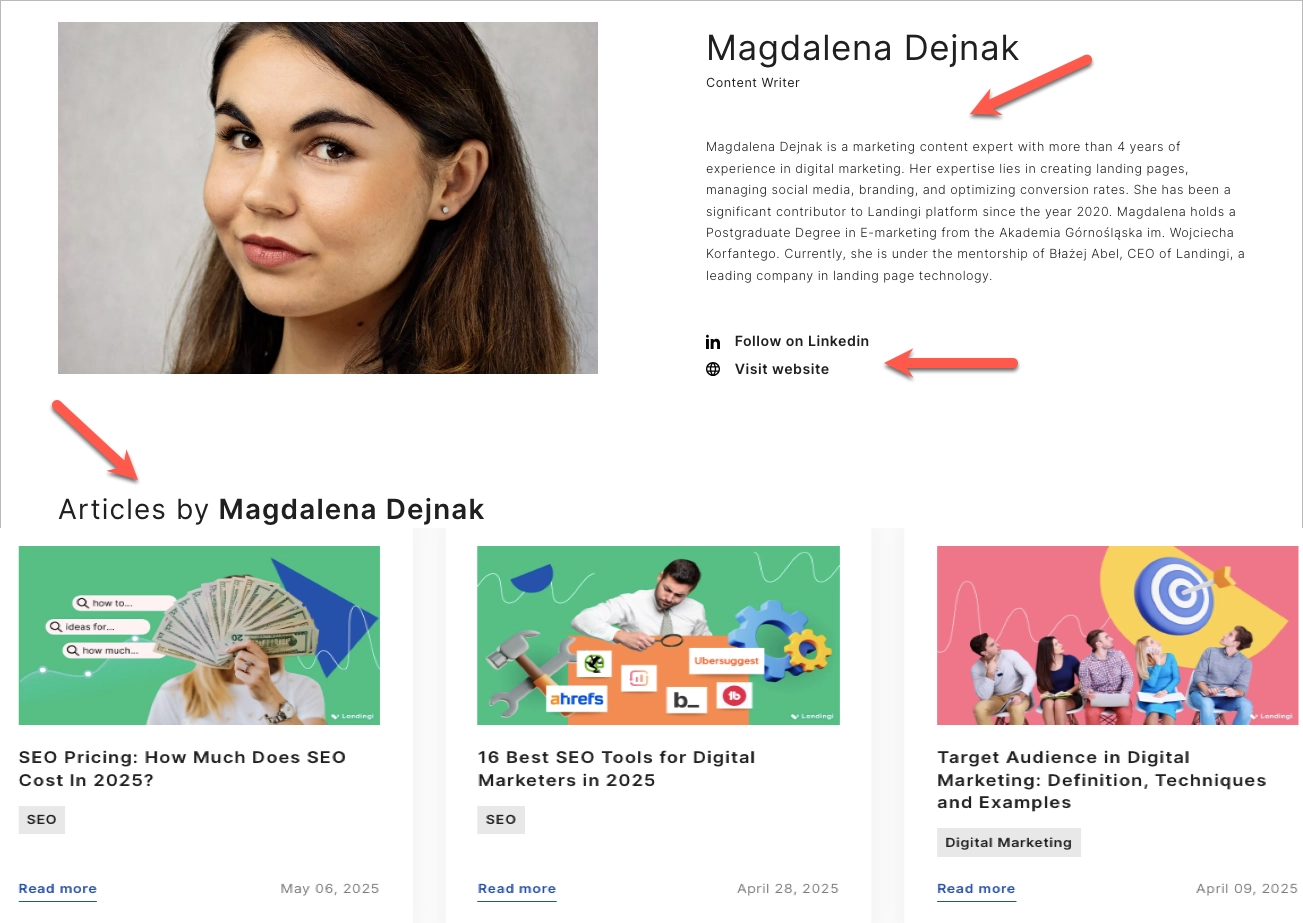
Google’s quality raters are explicitly trained to look for these signals. And while they don’t directly impact rankings, they inform how algorithms learn to assess trust and authority across millions of pages.
But the impact isn’t only algorithmic. Users also decide in seconds whether a page feels credible. If your article looks anonymous, unsupported, or templated—even if it’s factually accurate—it’s less likely to be read, shared, or linked to. And that directly affects SEO.
Improving E-E-A-T on-site isn’t a technical fix—it’s a strategic mindset. You’re not just writing for Google. You’re showing your expertise, proving your authority, and earning trust in every paragraph.
4 E-E-A-T Optimization Examples
Pro Tip: Run your top-performing content through a “credibility pass.” Ask:
- Is the author visible and qualified?
- Are sources cited, current, and trustworthy?
- Would a new visitor immediately feel they’re in good hands?
Optimizing for E-E-A-T is about making your expertise and credibility visible on the page. Here’s how that plays out in four key areas, with clear examples of what works and what does not.
#1 Author Bylines and Bios
Readers and search engines want to know who is behind the content they’re reading—and why they should trust them.
Good Example:
“Written by Sarah Jennings, Content Strategist with 10+ years in SaaS growth marketing. Featured in HubSpot and Content Marketing Institute.” Bio includes a headshot, credentials, and links to relevant work.
Bad Example:
Post attributed to “Marketing Team” with no author page, no visible bio, and no way to check qualifications.
Takeaway: Clear authorship builds credibility—anonymous or faceless content weakens it.
#2 Creating Helpful Content
Google rewards content that reflects real-world use—not just surface-level explanations.
Good Example:
A Notion tutorial that includes: “I’ve used Notion to manage a 6-person team. Here’s how we organize workflows using linked databases.” Includes screenshots, mistakes, and takeaways.
Bad Example:
A generic overview of Notion’s features, rewritten from their homepage, with no personal insights or examples.
Takeaway: Content that feels lived-in reads differently—and Google can tell.
#3 Citing Credible Sources
Backing up claims with reliable sources signals expertise and accuracy.
Good Example:
A health article links to Harvard research, includes studies from PubMed, and attributes all data to named, current sources.
Bad Example:
Same topic, but includes vague phrases like “studies show” with broken or irrelevant links.
Takeaway: Without solid sourcing, even well-written content loses authority.
#4 On-Site Trust Signals
Trustworthiness isn’t just about what’s on the page—it’s also about the structure around it.
Good Example:
An ecommerce site with a detailed About page, visible contact info, active HTTPS, customer reviews, and clear policies on privacy and returns.
Bad Example:
No team info, no legal pages, no visible trust signals, and a contact form that leads nowhere.
Takeaway: A trustworthy site layout reinforces your content’s credibility—bad UX undermines it.
Create trustworthy, SEO-optimized landing pages with fast load times and a user-friendly layout
How to Create E-E-A-T Audit?
To create an E-E-A-T audit, you need to look at your site the way Google’s quality raters do: through the lens of trust, expertise, and credibility. It’s not just about checking for broken links or updating keywords. It’s about understanding whether your content—and the people behind it—deserve to be seen as reliable in search engine results.
Here’s a step-by-step process to evaluate how well your content aligns with Google’s quality guidelines, identify weak points, and prioritize improvements that boost both rankings and user trust.
Step 1: Evaluate Author Presence
Strong E-E-A-T begins with clear authorship. Content created by experts—or by people with real, relevant experience—has a better chance of being viewed as trustworthy content by both users and search engines.
Ask:
- Do all key blog posts and articles have named authors?
- Are contributor bios visible and complete?
- Do bios mention adequate expertise, such as job roles, credentials, or years of experience?
- Are there links to other sites that validate the author (LinkedIn, publications, interviews)?
Anonymous content, or vague “Team” bylines, weaken your site’s E-E-A-T signals—especially on financial stability, health, or safety pages.
Step 2: Check for On-Site Trust Signals
Trust isn’t just in the words—it’s in the structure. Google and users alike look for common indicators that the site is run by a real, transparent organization.
Make sure your site includes:
- An About page that explains who owns and runs the site
- A Contact page with direct email, phone, or team info—not just a form
- Privacy Policy and Terms of Service
- Secure HTTPS, fast load speed, and mobile-friendly design
Missing or hard-to-find trust pages suggest low transparency—especially problematic for ecommerce or YMYL sites. Google’s quality rater guidelines explicitly call these out in page quality rating.
Step 3: Assess Reputation and Reviews
Google values what other authoritative sites and users say about you just as much as what you say about yourself.
To assess your brand reputation:
- Google your site or company name + “reviews”
- Check if you’re mentioned on credible platforms (industry blogs, directories, trusted forums)
- Look for guest posts, expert quotes, podcast features, or citations
- Review ratings on platforms like Trustpilot, G2, or Google Business Profile
A positive reputation supports your E-E-A-T score, while a lack of mentions—or visible negative feedback—can signal low authority to both Google’s algorithm and your audience.
Use Landingi to add social proof, certifications, and expert insights — all in just a few clicks.
Step 4: Analyze Content Quality and Depth
High-quality content shows that your team knows the subject and is invested in providing helpful content that goes beyond surface-level summaries.
Audit your top pages for:
- Properly cited sources from authoritative or trustworthy sources
- Personal experience (especially in reviews, tutorials, case studies)
- Subject matter expertise, professional tone, and clear insights
- Unique value—not just a rehash of what’s already ranking
Step 5: Identify Gaps and Prioritize Fixes
After reviewing your site’s content, make a clear list of what needs to be improved.
Track:
- Pages missing bios or clear author information
- Posts without citations or external references
- Articles that lack depth or feel templated
- Sections without basic trust elements (legal pages, contact, HTTPS)
Start with high-traffic pages and YMYL content, where the impact of weak E-E-A-T is greatest. Use an internal content strategy doc or spreadsheet to assign fixes and monitor updates.
A thorough E-E-A-T audit helps you move from guessing to knowing where your content quality stands. It connects your SEO strategy with what Google values most: trustworthy, expert-driven, user-focused content. And in a world of saturated results and AI copycats, that’s how you stand out.
What Are the Limitations of EEAT in SEO?
The limitations of E-E-A-T in SEO include its indirect nature as a ranking factor, the subjectivity of trust and authority across different topics, the difficulty of faking genuine expertise, and the long-term effort required to build real credibility.
Although E-E-A-T plays a huge role in how Google’s algorithm evaluates content quality, it isn’t something you can track with a score or checkbox. Unlike Core Web Vitals or backlinks, it doesn’t show up in Google Search Console. That’s because E-E-A-T isn’t a single ranking signal—it’s a set of quality indicators drawn from various sources: author transparency, subject matter expertise, on-site trust elements, and your site’s overall reputation across search engine results pages.
It’s also highly contextual. What demonstrates adequate expertise depends on the search intent and the topic. A restaurant review written by a local foodie might earn more trust than one from a generic travel site. Meanwhile, a guide on tax form downloads provided by a random blog post won’t perform well unless it shows real qualifications or links to an authoritative or trustworthy source. Google’s quality raters evaluate this nuance through the search quality rater guidelines, and Google’s systems are trained to weigh these signals accordingly.
Then there’s the authenticity factor. You can’t fake E-E-A-T. Adding an author box or stuffing bios with keywords won’t work unless the content created genuinely reflects real experience or in-depth knowledge. Google values reputation signals it can verify—mentions from other authoritative sites, earned backlinks, or positive reputation across platforms. Faking credentials, buying reviews, or dressing up AI-generated content won’t pass a closer inspection.
And finally, E-E-A-T isn’t built overnight. For site owners and content creators, creating helpful, high-quality content that demonstrates real authority takes time. It’s the result of consistent publishing, thoughtful content strategy, and patience. You won’t gain search performance immediately—but over time, it shapes how your content ranks, how users engage, and how trustworthy your site’s content appears compared to competitors.
So while E-E-A-T has its limits—it’s subjective, indirect, hard to fake, and slow to build—it’s still one of the most important frameworks in search engine optimization.
Build landing pages that do more than look good — they build authority, boost rankings, and earn clicks.
Use EEAT SEO to Boost Traffic on Your Landing Pages
Landing pages aren’t just about design or copy—they’re about trust. You can have the perfect headline, polished visuals, and a strong CTA, but if your visitors don’t trust what they see, they won’t convert. And in today’s search results, where users bounce fast and decide even faster, applying E-E-A-T Google principles might be your most valuable competitive edge.
For marketers building pages to generate leads, promote SaaS products, or drive ecommerce sales, Experience, Expertise, Authoritativeness, and Trustworthiness are real conversion drivers. A landing page that reflects those qualities attracts traffic from search engines and gives people a reason to stay and take action.
So check your content. Do you show real experience through customer quotes? Is your expertise visible in bios or company info? Are you building authority with third-party mentions or partnerships? And are trust elements—like refund policies, HTTPS, or contact info—easy to find?
These aren’t just best practices. According to the E-E-A-T guideline, they’re key to building quality content that performs. And if you’re using Landingi, adding those trust signals is simple. From testimonials to team sections, every block helps you build landing pages that not only look great but feel credible on both sides of the click. In the end, SEO brings people in. E-E-A-T gives them a reason to believe.



